Family Tree of Robert Morrison 1740
Navigate this page
| Family Tree Viewing | Anson Morrison Letters | Newsletters | Morrison Volume Sets |
|---|---|---|---|
| Morrison Sketches 1700 | Morrison Sketches 1800 | Morrison Sketches 1900 | Hold |
Family Tree Viewing
(See downloads page to download these as a gedcom file.)
Downloads Page
| Robert Morrison 1740 | Full file | Robert Morrison 1740 View |
|---|---|---|
| Royalty Morrison | Rome to Morrison | View Royalty Tree |
| Mayflower Morrison | Francis Cooke to Morrison | View Mayflower Tree |
The Robert Morrison 1740 tree has the full Morrison tree from the Strowbridge book. It also has been updated for all of the descendants of John Keith Morrison to present. In addition, the ancestors of Charlotte Reed Brown Morrison back to England have been added. Where contact with other family relations and cousins has brought additional relatives and information, that has been added as well. This includes a family tree published on the web of John Morrison (1743-1801) who moved to Enfield, CN.
The Royalty tree traces Charlotte Reed Brown Morrison back to Mercy Dudley, daughter of Governor Dudley of Massachusetts. The Dudleys trace their family back to the Dudleys of England and royalty. This does have some controversy, as some dispute this connection.
The Mayflower tree traces Mary (Polly) Keith, mother of John Keith Morrison, back to Francis Cooke of the Mayflower. This is documented by the "Keith Book". This book shows that Mary Keith was the sister of Desire Keith, and the daughter of Joseph Keith and Chloe Packard. Note that John Keith's elder sister was named Chloe.
Anson Reed Morrison Letters
| Anson Morrison Letters | Supplement to Book | View/Download Supplement |
| Anson Morrison Letters | Cordaville 1857-1858 | View/Download Cordaville |
| Anson Morrison Letters | West Boylston 1859-1861 | View/Download W Boylston I |
| Anson Morrison Letters | Civil War 1861-1862 | View/Download Civil War I |
| Anson Morrison Letters | Civil War 1863 Jan-Sept | View/Download Civil War II |
| Anson Morrison Letters | Civil War Oct 1863-1864 | View/Download Civil War III |
| Anson Morrison Letters | West Boylson 1864-1867 | View/Download W Boylston II |
| Anson Morrison Letters | Chicago 1868-1870 | View/Download Chicago I |
| Anson Morrison Letters | Chicago 1871-1874 | View/Download Chicago II |
| Anson Morrison Letters | Chicago 1875-1877 | View/Download Chicago III |
| Anson Morrison Letters | John Henry 1876 | View/Download John Henry |
There are 150 letters written in the years 1857 through 1876. Most of these letters were published in a booklet that was distributed to family members who covered the cost of the printing. There were about 27 letters that did not get into this printing. They are available for viewing or download above described as the "Supplement". These additional letters were very interesting, and revealed that John Keith did write a letter in 1865 to Charlotte likely from Australia.
These letters were likely handed down from Charlotte to her daughter Maria, and then to Anson's daughter Lottie. Lottie married Joseph T. Buckley and had a son Richard Buckley in 1906. It was a meeting between Jim Morrison, Carolyn Sharp and Richard in late 2005 where the letters were revealed.
A Visit with Richard Buckley
Richard entered into eternal rest on May 27, 2006, at the age of 99, less than one year after the visit.
The total set of letters has been split into ten series for easier downloading and viewing. They are in PDF form, and are viewable by any Adobe Reader program which is a free software. Some of the letters need to be rotated clockwise for reading. All of the original letters were handwritten. Some that were difficult to read were transcribed and typed for easier reading.
Letters of Anson Reed Morrison
1856 – 1858
Location: Cordaville, Massachusetts
There are 13 letters in this section.
The first two are written by Mr. Wallace McFarland, who managed the boot shop in Cordaville and was enquiring if Anson (age 17) would like to work for him and learn the trade.
Anson’s first letters in 1857 indicate he was uncomfortable with writing letters. He arrives in March of 1857 to begin his apprenticeship. The place of business is O. S. Sanford and Company.
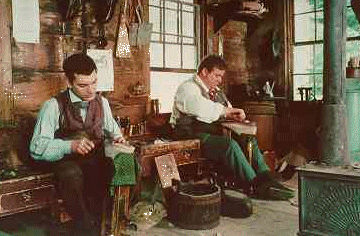
The letters usually begin with the state of health, or commenting on the health of Charlotte back in Skowhegan, Maine. Health and sickness were common hardships in these days, as drugs were not available for even the most common ailments. This was to be the subject of many a letter throughout their lives. When feeling good, the word was “first rate”.
In the letters of 1857, we learn that father (John Keith Morrison who went to Australia for gold in 1854) was heard from, and that he sent a watch to Anson. It was to be one of only two times they received a letter from him from down under. The other common theme of the letters from 1857 to 1876 was the absence of news from father and from Henry (John Henry Morrison, Anson’s elder brother).
In July of 1857, Anson was informed that Grandmother died. It was likely Mary (Polly) Morrison, who died at age 77 in that month. She was the wife of Robert Morrison, who moved his family to Maine in 1805. Robert Morrison died six months later.
Anson travels to Cordaville again in February of 1858 to resume work, arriving via the “Cars”. The “boat would be too rough”. The “cars” were undoubtedly the train. In September, Anson says he is “going to writing school”. His handwriting improves dramatically in his letters 1859 forward from West Boylston (next section).
A boarder by the name of Weston is staying with Charlotte in Skowhegan during these years. He may be the mystery man that was listed as John Morrison in the 1860 US Census, as Charlotte may have been embarrassed to have a man (not her husband) staying in the house. Weston apparently didn’t help much with the work, and was tardy with any rent.
Finally, in December of 1858, Anson hears from Henry who is traveling the river cities along the Mississippi. He weighs 175 pounds, which Anson remarks “I don’t think he is hurting himself at hard work!”
Letters of Anson Reed Morrison
1859 - 1861
Location: West Boylston, Massachusetts
There are 5 letters in this section.
The first one is written in 1859 and reveals that Mr. McFarland moved to another store in West Boylston about 22 miles Northwest of Cordaville.
 The letter in April of 1860 indicates that the Morrisons were Baptists, as Anson tells his mother he “went to a Baptist church and liked it very much”. He is astonished at Henry who appears to move from “one place to another”.
The letter in April of 1860 indicates that the Morrisons were Baptists, as Anson tells his mother he “went to a Baptist church and liked it very much”. He is astonished at Henry who appears to move from “one place to another”.
A letter in November of 1860 refers to Maria and her likely pregnancy with Forrest. Forrest was born February 16, 1861. Maria's husband was James Milford Brown, who is buried next to her in the Southside Cemetery in Skowhegan. Anson says in his letter “Ask Maria if she is not agoing to ask a feller to her wedding or is she agoing to have all the fun to herself”. It appears the pregnancy was a surprise, and there is no mention in the letters that James and Maria lived together. There are marriage records that indicate they were married after James served in the war in 1864. The census of 1870 shows that Forrest and Maria lived with Charlotte in her home. James Milford Brown died in 1871. Anson refers to himself in this letter as “the Boy”, which is a term he uses in his Civil War letters.
In January of 1861, his letter refers to the “Southern difficulties”, and the hope that things will be different when “Old Abe comes in”. Lincoln had already been elected, and was to be sworn in as President in March of 1861.
Letters of Anson Reed Morrison
1861 - 1864
Location: The Civil War
There are 53 letters in this section written during the Civil War. There is also a copy of Anson’s discharge and a military certification prepared in 1890.
The first letter is one of the few we have from Charlotte Morrison, Anson’s mother. Charlotte’s letter is one of emotion, seeing her son go off to war, and impressing upon him that his belief in “the Savior” will guide him in this world and the next. She writes the words that Anson adds to the small bible that his mother has given him to take with him during the war. These words are “If we are not permitted to meet again on earth, may we meet in heaven”.
Anson joined the Maine Volunteer 3rd Regiment on April 24, 12 days after the firing on Fort Sumter. Three months later, he was taken prisoner in the Battle of Bull Run.
Anson’s first letters upon arriving in Washington, D.C., are full of confidence and the belief that the war will be short and swift. It appears that (John) Henry has continued his travels from city to city along the Mississippi, and has not joined the war effort. In Alexandria, the crowds gather at the sight of the marching Union army cheering for our Boys singing “go get Jeff Davis and shoot him dead”.
Following letters are after the route of the Union Army at Bull Run. Anson is captured and a prisoner of war. During the first year, prisoners of war were usually well cared for and were freed in prisoner of war exchanges between the two armies. Later this practice was stopped and the Confederate prisons were turned into death traps as the war dragged on. From prison Anson wrote upon his return home, “don’t think you will see me in the army again”. His comment that there was “not much fun in it”, showed just how naïve the volunteers were at the beginning of the war. He wanted no more of the “sight” he saw at the Battle. Unfortunately, Anson had signed up for three years and there was no going home for a good while.
Anson was freed in May of 1862 in a prisoner exchange, and arrived in New York aboard the Steamer named the Guide. He went from there to Annapolis where he stayed until he rejoined his regiment later in the fall. Letters from here indicate there were 1400 sick and wounded staying in the hospital. Henry writes and asks for money, and $25 in “US Notes” are sent. Henry has a “woman” and sends a picture of the two of them, noted as his wife. Since Margaret Murphy was only 8 years old in 1862, this must have been his first wife, whom we had no record of.
Anson is leaving Annapolis in his letter of October 27, 1862. Apparently, they needed word of his official “exchange” before he could return to his regiment. One of Charlotte’s letters Anson receives on the battlefield December 17, and he replies after the Union army retreats across the Rappahannock River. In this letter, he talks of a late evening meeting of rebels and union officers shaking hands and exchanging tobacco for coffee, while they collected the dead from the battlefield.
After the Battle of Fredericksburg, Anson displays his emotion at the pointless loss of life in his December 27, 1862 letter. The lack of any mention of Christmas displays just how low the morale was in the Union army at this time. Anson is tired, and his side has been injured, though we don’t know to what extent. It is hard for him to stand.
The Union army sets camp across the Rappahannock River for a few months to let the rainy winter season pass by. There is too much mud and rain for cavalry and infantry battles. Several letters are written and Anson builds a log house for himself and others. A letter from Henry says he is still in Memphis. This is a very tough time for Anson, as he sees the “two year” volunteers going home, and he is required to stay for his signup period of three years.
The next battle occurs the first of May at Chancellorsville. Also called the infamous “Wilderness” where infantry moved but didn’t know who was 10 feet from them, friend or foe. There were 17 thousand casualties on the Union side, but the Confederates lose 12 thousand that cannot be replaced, and also lose Stonewall Jackson – shot by his own men in the Wilderness.
He hears rumors of a conscription of men to add to the Union Army, and he shows his fury with those who are “laying back”. “If we get the men, we can win this thing”, he says.
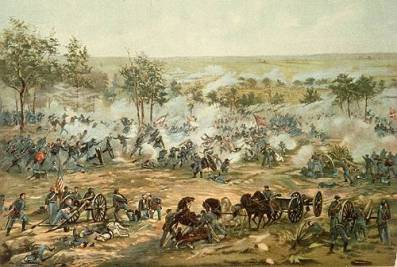 Gettysburg June, 1863 Day by day description |
Anson writes a letter on July 22 to his mother. My “Company suffered severely” he says. But the tone of his letter is more upbeat, and it is clear that the morale of the Union army is high. Charlotte, having heard of the fierce battle, had not heard from Anson and spent several weeks in deep despair that something terrible had happened to him.
From August until the middle of October of 1863, the Regiment made camp and waited for conscripts to train. In September, Henry writes that he is now a father. Three months later, the child dies. Henry writes perhaps one to two more letters before he drops out of sight for more than 9 years. In November, Anson is promoted to Sergeant Major and offered a Captain’s position if he would sign up. Anson wants nothing of it, despite the tempting pay. He begins to count the months and the days until his tour of duty is over.
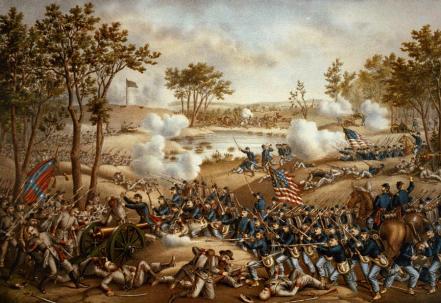 In January, the Company settles in for the winter and Anson has several pictures taken in the Camp. This is where his picture is taken by the famous photographer – Brady. With only about a month to go, the Union Army fights several intense battles. The second Battle of the Wilderness causes severe losses in the Maine regiment. Anson says 200 to 300 casualties. How difficult it must have been to be within days of discharge, and to have the enemy in a wilderness where you cannot see more than 10 feet. Anson fights in the last battles of May in Spottsylania and Cold Harbor. However, before the final Union disastrous charge at Cold Harbor (picture above) ordered by Grant, Anson's three year tour of duty ends. Anson and several men in his troop are allowed to leave the battlefield to go home to Maine. Surely, the officers knew of the pending doom and allowed those that had served for three years not to lose their life in the last hours of their service. Anson is indeed lucky as the Union has 13,000 casualties to the Confederacy's 2,500. He leaves at the beginning of June for Maine, and arrives in Augusta on June 11.
In January, the Company settles in for the winter and Anson has several pictures taken in the Camp. This is where his picture is taken by the famous photographer – Brady. With only about a month to go, the Union Army fights several intense battles. The second Battle of the Wilderness causes severe losses in the Maine regiment. Anson says 200 to 300 casualties. How difficult it must have been to be within days of discharge, and to have the enemy in a wilderness where you cannot see more than 10 feet. Anson fights in the last battles of May in Spottsylania and Cold Harbor. However, before the final Union disastrous charge at Cold Harbor (picture above) ordered by Grant, Anson's three year tour of duty ends. Anson and several men in his troop are allowed to leave the battlefield to go home to Maine. Surely, the officers knew of the pending doom and allowed those that had served for three years not to lose their life in the last hours of their service. Anson is indeed lucky as the Union has 13,000 casualties to the Confederacy's 2,500. He leaves at the beginning of June for Maine, and arrives in Augusta on June 11. His wife to be, Margaret Gilhooley is waiting for him there in Augusta.
Letters of Anson Reed Morrison
1864 - 1867
Location: West Boylston, MA
There are 15 letters in this section.
Anson begins work again in the boot shop in West Boylston where he is likely boarding again with the McFarlands. Margaret (Maggie) Gilhooley, his sweetheart, is likely boarding there also. They marry in early 1866 (See Vital Records section for a certified copy of their marriage), since Anson begins to write his mother of Maggie’s health as well as his own. There are also references to the first year together boarding, and the second where they have their own home.
Most of the letters are similar, talking of health and the absence of letters from Henry and Father (John Keith). Henry writes two letters during this period, in November of 1866 and again in December of 1867. It appears he is still in the South, likely Memphis, and it appears he is again single. No reference to his first wife. He is not to be heard from again until 1876.
The big news is a letter from John Keith in August of 1865. The previous letter was eight years before. He likely was still in Australia, but no mention is made of his address. As far as we know, this is the last anyone would hear from John Keith Morrison.
In January of 1868, Anson and Maggie leave for Chicago to start a new life.
Letters of John Henry Morrison
1876
Location: St. Louis
There are 3 letters in this section.
While John Henry did write his mother other letters, we only have two of them written in 1876. The first of these letters was written in February of 1876, after a visit from Anson in St. Louis. It was his first in over 9 years. He says "I hardly know how to commence this letter or what to write".
He appears to have settled down in St. Louis marrying Margaret Murphy in 1869 or 1870. Margaret was 16 at the time, and John Henry would have been about 34. They had great difficulty during the first five years of marriage, burying four of their children.
John Henry says he is sorry to hear that Maria had lost her husband. James Milford Brown died in November of 1871. 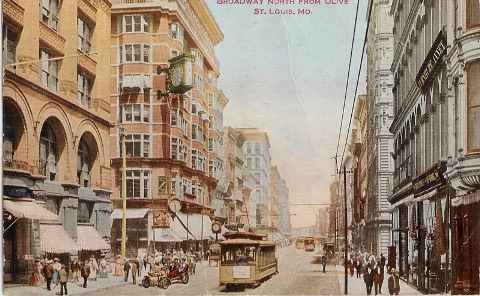 Broadway 1910 Image courtesy of Scott K. Williams www.stlouistimeportal.com |
Another letter was written by Maria to Lottie in 1906, after Lottie had her first baby. This baby boy was Richard Buckley.
In the letter, Maria had sent several pictures of Anson taken during the war. One was in prison, where he was standing with two others. “The flag is at his head, and his coat is buttoned up”. While we have a tin picture of Anson, it appears the other pictures have been lost.
Letters of Anson Reed Morrison
1868 - 1877
Location: Chicago
There are 36 letters in this section.
The first letters of 1868 from Anson to his mother tell of his arrival in Chicago, and his pride in buying a home. They first lived at North Peoria Street No 47, but soon moved to 48 West Randolph Street. Anson paid $3,500 for the house, and had a mortgage of $1,500 to pay at 10% interest. Anson was making $24 a week, and Maggie made $15. They saved a great deal from their wages to pay down the mortgage. The house had “good air” as the wind blew in from the lake, and there was open prairie on the other side.
It appears that the McFarlands moved to Chicago as well. But it is not evident that Anson worked at his shop, or had his own. One letter mentioned that strawberries were 10 cents a quart.
In 1869, Maggie returned to Worcester to visit her sister who was very ill. She was living with a Mrs. Warren. She died a few months later of consumption (tuberculosis). In October, Ann Morrison visited. It is possible that this was the daughter (Clara Ann) of Lucius Morrison, brother to John Keith. Clara Ann was a primary source of information for the Morrisons of Maine for the Strowbridge book written in 1891.
In the letters of 1870, there is mention of a meeting with a Mr. Stevens who spoke highly of Henry (John Henry). Henry had lived with the Stevens for four years 1860 through 1864. It appears that Henry never joined the war effort. Anson and Maggie both worked in the boot shop, and described their new shop as having much better light. Albert Morrison was born March 24, 1871.
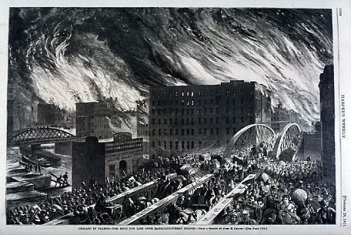 Chicago 1871 Chicago Fire click here for more pictures | During the next year, they spoke proudly of the city and its rebuilding. They thought it would be the “banner city” of the world. Lottie was born November 6, 1872. These were happy years. |
Just as the Panic of 1873 unfolded, Chicagoans had hosted an Inter-State Industrial Exposition to call attention to their rapid rebound from the great fire. But the depression that lasted for the rest of the decade temporarily slowed the city's growth. Industrialists and entrepreneurs lost fortunes. One in three workers lacked employment. Many workers had come to Chicago in order to take part in the city's reconstruction. Now many of these recently arrived, single male immigrants, walked the streets as tramps.
Click here to learn about Chicago during the Gilded Age 1873 to 1876
The letters during this period spoke of poor business and very cold weather. Maggie and Albert did not fair well and were sick much of the time. However, Lottie was energetic and healthy. In August of 1875, Maggie and the children took a trip back east to visit her folks in Worcester, and Charlotte in Skowhegan. The children spoke of this trip often, but it only solidified Maggie’s desire to move back East. In her letter of February 13, 1876, she writes about Chicago “It is very sickly in the city”. This is the last we hear from her. Margaret (Maggie) Morrison dies sometime in the spring or summer.
The next we hear from Anson is a depressing letter where he writes his mother that he misses his children but they are “in a better place”. He took them back east to live with Mrs. Ann Phipps, possibly a close relative. He says he “must wait”. Perhaps he had planned on moving back East to live with them, but that never happens. He signs guardianship papers in 1877 that place Albert and Maggie with two families of McGrail, one who is John McGrail and wife Lucy Phipps. The McGrails were cousins of Anson's wife Maggie. Maybe Anson felt he could not find a decent job back east.
Charlotte Morrison dies in April of 1877, so the recipient of all these letters, and the one we have to thank for protecting them, has passed on. Anson follows only three years later at age 40.
Newsletters
| Newsletter | April 2005 | Cover Page |
|---|---|---|
| Newsletter | April 2005 | Page Two |
| Newsletter | April 2005 | Page Three |
| Newsletter | April 2005 | Page Four |
This newletter published on the web does not transfer perfectly. There are some lines that are truncated in some sections.
Noted corrections:
Anson Reed Morrison wife was not a McGrail. Her maiden name was Gilhooley. And they called her Maggie. Her relation to the McGrails is unknown, but they may have been first cousins from Ireland.
Morrison Volumes
These volumes document the work started in 2000 by Carolyn (Morrison) Sharp, and jointly continued with Jim Morrison over the following five years. These volumes focus on the family who descended from John Henry Morrison (1835 - 1890). John Henry settled in St. Louis after marrying Margaret Murphy around 1868.
As time allows, these volumes will be scanned to the web site.
Volume I
The Morrison Family: A wonderful photo album of the Morrisons from 1900 forward.
Volume II
The Morrison Family: Research by Carolyn Sharp offers legal document copies, Athlone Avenue Memories, and the St. Louis Directories.
Volume III
The Morrisons of Maine: Carolyn shows us our Maine heritage, Civil War stories, and our family back to 1830. Family Tree prepared from family notes from John Keith Morrison (1809 - 1886).
Volume IV
Morrison Memories: Recollections of the Greatest Generation by those who knew them the best.
Volume V
Colonial Morrisons: Research by Jim Morrison finds the 1891 published book by Mary Guild that traces the family back to 1740. Mayflower and Revolutionary War connections.
Volume VI
Mayflower Ancestors: Mayflower articles about Francis Cooke, and other pilgrims. Old New England maps. Scottish origins.
Volume VII
The Anson Reed Morrison Letters 1857-1877. About 156 letters primarily from Anson to his mother Charlotte Brown Reed Morrison, many of them during the Civil War. Anson served in the Maine 3rd Regiment, which saw action at Gettysburg. Anson and his wife also experienced the Chicago fire of 1876.
Sketches and stories of Morrisons in the 1700's and before
Navigate this page
| Robert Morrison | William Morrison | Hold | Hold |
|---|
Robert Morrison 169? - 1764
To be completed...
William Morrison 172? - 1758
To be completed...
Sketches and stories of Morrisons in the 1800's
Navigate this page
| John Keith Morrison | John Henry Morrison | Hold | Dorilus Morrison |
|---|---|---|---|
| Australia Gold Rush 1853 | Hold | Hold | Hold |
John Keith Morrison
John Keith Morrison was born in 1809, the fifth child of Robert and Mary (Keith) Morrison. He married Charlotte Brown Reed in 1832 and had nine children by her. One was John Henry, who moved eventually to St. Louis. Another was Anson Reed who served in the Civil War. He lost four children, a brother and a sister in the span of two years, and in 1854 left for Australia for gold and possibly to just get away for awhile. He never returned.
The book "Skowhegan on the Kennebuc" relates the following. "The Sons of Temperance organized nationally in September of 1842. Skowhegan Division No 66 was instituted February 2, 1847 with 102 members. Of the first officers was John Keith Morrison. The Constitution pledge was 'No brother shall make, sell or use as a beverage any Spirituous Malt Liquors, Wine or Cider'". I guess somewhere over the years, we Morrisons lost our ways!
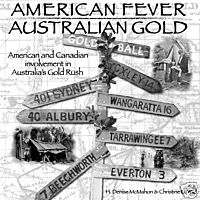
Researchers in Australia have been working five years on a project concerning the Americans and Canadians who went to Australia in the 1850's in search of gold. The CD "American Fever Australian Gold" lists over 1700 names on 1,100 pages of history, maps and pictures. John Keith Morrison was the subject of his own five page chapter.
It's a fascinating read on the two year period 1852 to 1854, when over 500 ships and vessels were lost at sea carrying adventurers to Australia to seek their fortune.
John Keith or the mention of "Morrison from Bloomfield" is mentioned almost 40 times throughout the book. Bloomfield being the town of Skowhegan in 1853. Their research found John Keith on the ship "Rockland" which sailed from New York to Melbourne on a four month voyage. The ship made an unscheduled stop in Rio de Janeiro to take care of some mutineers. His cabin roommates were the Allen boys and Reed from Madison. Below is an advertisement for a similar voyage from Liverpool.
Click on this link to read an email from a researcher in Australia about John Keith and the ships from Maine to search for gold. Australia email

Reed was likely a relation of Charlotte Reed Morrison, his wife. Possibly Woodbridge Brown Reed, who was about John Keith's age. John Keith was in Melbourne when he landed and was still there a few years later. He was in Beechworth in 1855, about 200 miles northeast of Melbourne, where he held a job as a boss in a sawmill. There he was brought into court to pay a worker some disputed wages. They found dead letters to John Keith in Yackandandah just slightly north of there in 1858. Letters likely from Charlotte his wife.
Eventually, John Keith made his way further northeast about another 150 miles northeast into New South Wales where he held various jobs as a carpenter or bricklayer. He was in Tumut in 1866, but eventually moved further north to Junee where in 1878 he became insolvent and registered his financial papers. This was a year after Charlotte, his wife died in Skowhegan, Maine. There were countless letters and communications from Maine to Australia, and the community there may have relayed that sad news to him. He never saw his wife again, and very rarely mailed her as is known from the letters his son wrote to his mother throughtout the 1870's. John Keith remained in Junee until he died in 1886, buried in the Church of England of the old Junee cemetery. No headstones appear to have survived. John Keith outlived his son Anson Reed, who died in 1880.
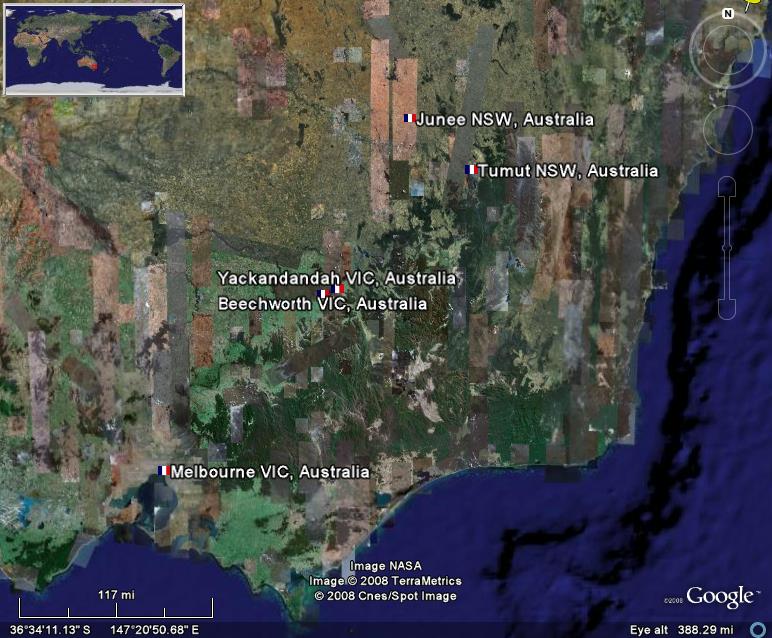
Following is an excerpt from a website on the CD book, which can be purchased for about $40 Australian.
American Fever Australian Gold re-enacts the daily life and experiences of over 170 men and women who were born or had lived in North America and who braved the high seas seeking their fortune on and beyond the gold-fields of Victoria, primarily in the north-eastern Ovens district, during the 1850s – 1870s. Devoting the last five years to this research, the authors found many tried their luck on the Californian fields before the news of great finds down-under tempted them to an adventure of a lifetime. They left behind their homes, families, and friends, but were not forgotten; hitherto unseen letters written from on-board ship or from the gold-fields to their loved ones back home described their precarious lives as they hunted for a sustainable income. In return, letters from parents and wives pleading for their loved one to return home, showed the anguish of those now in a far away land. American Fever Australian Gold tells how these travellers fared on their voyages; mutinies, disease, near starvation, it tells the routes they took, the stops they made and their thoughts about these foreign ports, their successes and failures, marriages, divorces, happy times and sadness. The narratives delve deeply into the daily lives of these men and women, many meeting up unexpectedly with family, friends and even former neighbours in what was a strange and exciting land.
The previous lack of recognition of the endeavours of these men in the history books of what quickly became an important part of Victoria was the driving force in the creation of American Fever Australian Gold. These men and women deserve to be acknowledged for their contribution to the development of new areas in both Australia and America. Some stayed in the southern continent, some returned home or moved to yet another new land; no matter where they went, the authors followed and documented their lives as they established themselves in various locations around the world. Engineers, miners, lawyers, men who held public office, politicians, storekeepers, coach proprietors, farmers, the loving family man, even those who fell foul of the law – all these and more are covered in American Fever Australian Gold.
So early did these travellers arrive in Victoria’s settlement that some died where officialdom had not yet reached, their deaths were never recorded, their families in a distant land left wondering. The authors have used primary and secondary resources, personal letters, diaries, and journals that revealed information never before seen, and as a result cleared up many family mysteries. This CD-Rom fully cited and with over 1100 pages in PDF format, is a must for history or gold mining aficionados, the family researcher, or as a gift for that hard to buy for friend or family member.
John Henry Morrison 1835 -1890
To be completed...
Dorilus Morrison - Pioneer and First Mayor of Minneapolis
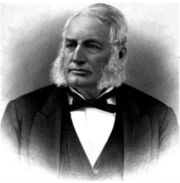
Dorilus Morrison (December 27, 1814–June 26, 1898) was a banker, businessman, and politician who lived in the U.S. state of Minnesota. He was the first and third mayor of Minneapolis. Morrison was born in Livermore, Maine.[1] He was the cousin of William D. Washburn, who also moved to Minneapolis. Washburn became a noted area businessman and later a U.S. Senator.
Dorilus Morrison was elected to represent the 5th district in the Minnesota State Senate and served from 1864 to 1865. He served two non-consecutive terms as mayor of Minneapolis in 1867–68 and 1869–70. Around that same time, he began building a streetcar line in the city. He joined with other businessmen, and eventually hired Thomas Lowry, who got the line up and running in 1875. The line eventually merged with a line in neighboring St. Paul to become Twin City Rapid Transit.
After Morrison died, his body was interred at Lakewood Cemetery in Minneapolis.
The following biography is a nice sketch of Dorilus, his son Clinton, and of Angus.
Biography Angus Washburn Morrison - Grandson of Dorilus Morrison
The Strowbridge book discusses the family of Dorilus on pages 200-201 as follows:
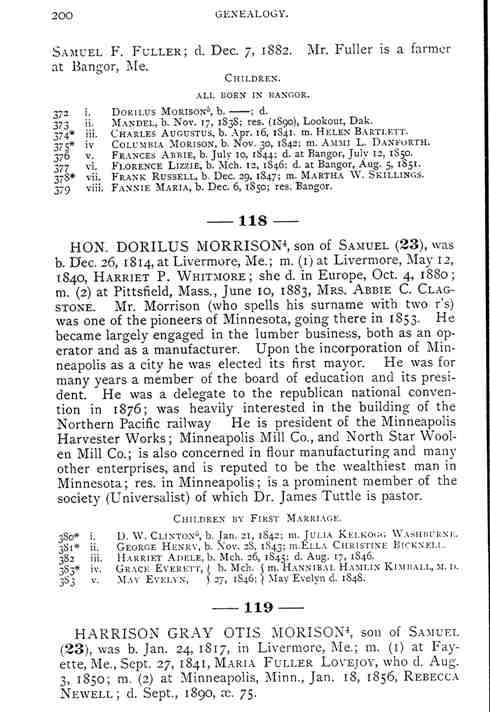
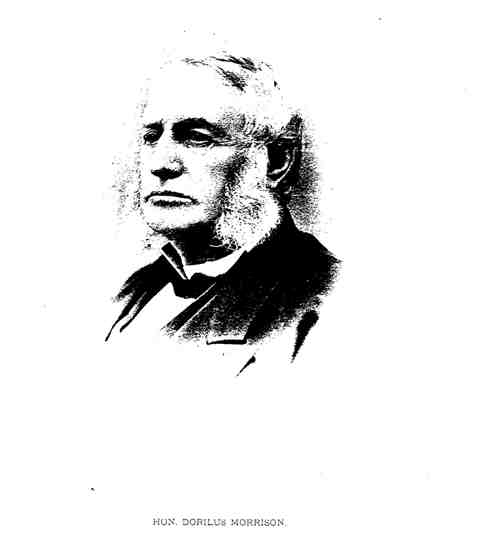
Australia Gold Rush 1851-1861
When gold was found in Australia, people came from far away. Hundreds of people came to look for gold.
This time was called the Gold Rush. It was a hard life digging for gold.
Some people found big nuggets of gold. Some people became rich but lots did not.
The Australian Gold Rush 1851
At a time when Australia was not yet a nation but still a number of separate British colonies, gold was discovered in a number of places, and the gold rush that followed changed our history. In the early days, traces of gold had been found but were hushed by the government, in fear that convicts and settlers would abandon the settlements to seek their fortunes.
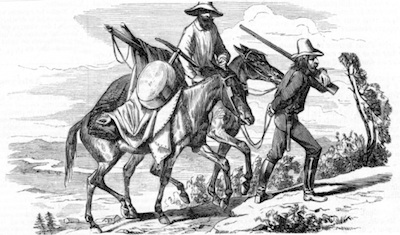
However, in February 1851, a man named Hargraves found gold in near Bathurst, New South Wales, and word quickly spread. Within a week there were over 400 people digging there for gold, and by June there were 2000. They named the goldfield Ophir after a city of gold in the Bible. The Australian gold rush had begun!
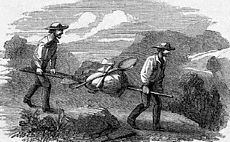
Between 1851 and 1861, Australia produced one third of the world's gold.
By the end of the 19th century, Australia was the largest producer of gold in the world.
So many people went to the goldfield that there was a shortage of people doing other work such as farming, building, baking and so on. Governor Fitz Roy was worried that there would be violence and lawlessness at the goldfields, and he ordered that gold seekers must pay for a licence in order to dig for gold.
Gold in Victoria
In August 1851, part of New South Wales was made into a separate colony, which was named Victoria after the Queen. Many Victorians had gone to the Ophir goldfields, and businessmen, to keep people from leaving the new colony, offered a prize of 200 guineas for the first person who found gold in Victoria. At around the same time, gold was found at Clunes, at Buninyong , and at Anderson's Creek near Warrandyte .
Towards the end of August 1851, James Reagan and John Dunlop discovered the richest goldfield the world has ever seen in a place the Aborigines called Balla arat, which means 'camping place', now the city of Ballarat. Other discoveries soon followed in Mount Alexander, now called Castlemaine, in Daylesford, Creswick, Maryborough, Bendigo and McIvor, now called Heathcote. Thousands of people left their homes and jobs and set off to the diggings to find their fortune. At the start of the gold rush, there were no roads to the goldfields, and no shops or houses there. People had to carry everything they needed. They travelled by horse or bullock, or by walking with a wheelbarrow loaded with possessions.
By the end of September 1851 there were about 10,000 people digging for gold near Ballarat. By 1852, the news had spread to England, Europe, China and America, and boatloads of people arrived in Melbourne and headed for the goldfields. The wealthy Bendigo goldfields were found by a woman, Margaret Kennedy, who saw gold in the creek bed in September 1851. She and a friend washed the gold using a breadmaking pan. Within a few months, there were about 20,000 people searching for gold in that area.
Life at the goldfields
Diggers in their hut 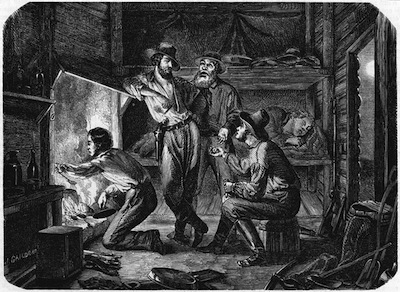 The space where someone was digging was called a 'claim'. To keep their claim, a person had to work on it every day except Sunday, so if no one was working a claim, someone else would take it. That was called claim jumping.
At the diggings, the gullies were filled with claims, and so the higher ground nearby soon became huge campsites. People lived in tents at first, but later on huts made from canvas, wood and bark were built.
The space where someone was digging was called a 'claim'. To keep their claim, a person had to work on it every day except Sunday, so if no one was working a claim, someone else would take it. That was called claim jumping.
At the diggings, the gullies were filled with claims, and so the higher ground nearby soon became huge campsites. People lived in tents at first, but later on huts made from canvas, wood and bark were built.
Gradually there were stores and traders and other amenities, but life remained hard. Food and other goods had to be brought in by cart and so were very expensive.The settlements were all rather makeshift and temporary. Gold buyers and traders set up stores. Hotels and boarding houses were established, built of wood and lined with calico. The government camps were made of wood, and included a jail and accommodation for the soldiers. At some goldfields there were even theatres where travelling performers entertained the diggers.
A few people struck good finds of gold and became rich, but many did not. Mostly the people who did well were the tradesmen who sold food and equipment, or landowners who sold land to people who wanted to build homes and settle down after the gold rush.
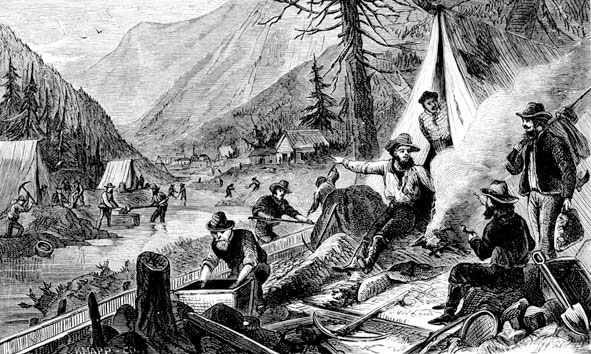
Settlements at the goldfields.
Getting to the goldfields
People came from all over the world, intending to strike it rich and return home to their own countries. For many, the journey to Australia took seven or eight months, and on the cheapest fares, conditions were tough. There were many epidemics of illness on the ships, and those who survived the journey arrived at the goldfields weak and unfit for the hard life on the diggings. Fresh food at the diggings was limited, and the basic diet was mutton, damper (a bread made of flour, water and salt, cooked over an open fire) and tea.
Clean water was in short supply because the diggers muddied the creeks, so cleanliness was difficult. Sewerage was not disposed of in a sanitary fashion, and disease was common. There were a few doctors or chemists at the diggings, but not all were qualified. Many people died of diseases such as dysentery (an intestinal disease) or typhoid (a disease spread by bacteria in contaminated water).
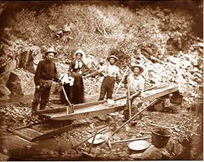 There was violence on the goldfields. Thousands of people intent on making a fortune were all crammed together in a small location, in rough accommodation with few comforts, and tensions rose easily. There were fights, often over claim jumping. The journey to and from Melbourne was long and hard, and dangers included bushrangers who held up travellers and robbed them. The police were brutal, many were ex convicts who were looking out for themselves.
There was violence on the goldfields. Thousands of people intent on making a fortune were all crammed together in a small location, in rough accommodation with few comforts, and tensions rose easily. There were fights, often over claim jumping. The journey to and from Melbourne was long and hard, and dangers included bushrangers who held up travellers and robbed them. The police were brutal, many were ex convicts who were looking out for themselves.
Women at the goldfields
At first there were mostly men at the diggings, but later on they were joined by their families. There were a few women who were diggers though, and there were women shopkeepers. Most women stayed home with their families however, usually with very little money to live o, while their husbands travelled to live and work on the goldfields. A few years later, many women took their children and joined their husbands when conditions improved, although there were always more men than women at the goldfields, and life was hard for all.
There were just a few women diggers 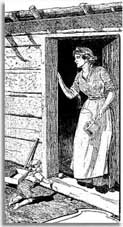
Women's work consisted of washing, ironing and cooking. They made bread, butter, jams, soap and clothes for the family.The living conditions were cramped, and there were few comforts at the diggings. Because the alluvial mining muddied the once clear creek water, clean drinkable water was hard to find. Often fresh water was carted in to the diggings and sold by the bucketful. Fresh vegetables and fruit were scarce and cost a lot. Usually when a woman gave birth to a baby, she was assisted by other women. There was little in the way of medical assistance in cases of illness or to assist the women in childbirth. Many women died while giving birth. Epidemics of illnesses such as diphtheria, whooping cough, measles, typhoid and scarlet fever swept through the goldfields, and many men, women and children died.
There were women among the entertainers who travelled around performing at the various goldfields. 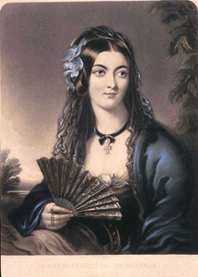 The most famous of these was Lola Montez, best known for her Spider Dance. She was immensely popular wherever she entertained. Lola Montez was showered with small gold nuggets by the diggers whenever she finished a performance.
The most famous of these was Lola Montez, best known for her Spider Dance. She was immensely popular wherever she entertained. Lola Montez was showered with small gold nuggets by the diggers whenever she finished a performance.
Lola Montez
Chinese people at the goldfields
The Chinese prospectors walked from South Australia to Victoria 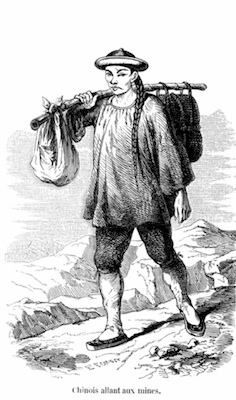 News of the Australian goldrush reached China in 1853, when that country had been suffering from years of war and famine. To raise money for the fare to Australia, a man would take a loan from a local trader, agreeing to send regular repayments. His wife and children stayed behind, and worked for the trader if the man was unable to repay the loan. In an attempt to limit the number of Chinese at the goldfields, a law was passed in 1885 that any Chinese person entering Victoria would pay ten pounds tax and one pound for a protection fee, for the right to mine and live in the colony. No one entering Victoria from any other country had to pay this tax. However, this did not reduce the numbers of Chinese. They landed in South Australia and walked several hundred kilometres to reach the Victorian goldfields.
News of the Australian goldrush reached China in 1853, when that country had been suffering from years of war and famine. To raise money for the fare to Australia, a man would take a loan from a local trader, agreeing to send regular repayments. His wife and children stayed behind, and worked for the trader if the man was unable to repay the loan. In an attempt to limit the number of Chinese at the goldfields, a law was passed in 1885 that any Chinese person entering Victoria would pay ten pounds tax and one pound for a protection fee, for the right to mine and live in the colony. No one entering Victoria from any other country had to pay this tax. However, this did not reduce the numbers of Chinese. They landed in South Australia and walked several hundred kilometres to reach the Victorian goldfields.
A Chinese temple at a goldfields settlement.
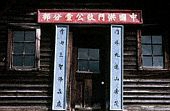 When they arrived at the goldfields, the Chinese stayed together in large teams, usually from the same village, with a head man in charge. Groups were allocated duties such as mining, cooking, or growing vegetables for the team. The Chinese were generally very hardworking and honest, and were quiet and law abiding. They lived simply, especially as they were sending money home to repay their fare. Much of the alluvial gold was running out and the Chinese miners re-worked claims that had been abandoned, preferring not to go deep underground for fear of offending the mountain gods, and they collected gold that had been missed. They also saw other opportunities to make money, and worked at other jobs around the diggings, such as washing clothes, selling vegetables they'd grown, selling cooked food or herbal medicines and so on.
When they arrived at the goldfields, the Chinese stayed together in large teams, usually from the same village, with a head man in charge. Groups were allocated duties such as mining, cooking, or growing vegetables for the team. The Chinese were generally very hardworking and honest, and were quiet and law abiding. They lived simply, especially as they were sending money home to repay their fare. Much of the alluvial gold was running out and the Chinese miners re-worked claims that had been abandoned, preferring not to go deep underground for fear of offending the mountain gods, and they collected gold that had been missed. They also saw other opportunities to make money, and worked at other jobs around the diggings, such as washing clothes, selling vegetables they'd grown, selling cooked food or herbal medicines and so on.
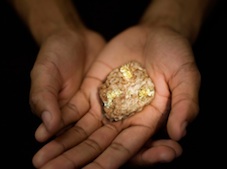
There was ignorance about Chinese customs and culture, and the Chinese seemed very strange and different to the European diggers. The people at the diggings were suspicious of them and resentful of their methods of mining. The appearance of the Chinese, with their pigtails and unfamiliar clothes, their habit of going barefoot and of carrying loads hanging from bamboo poles carried across their shoulders, their religion, all made them the target of a great deal of racism and prejudice. Local Chinese societies came into being, to advise newly arrived Chinese about how to fit in.
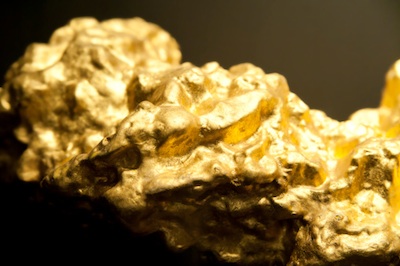 Some Chinese returned home after the gold rush, but many stayed here. They found jobs, set up market gardens, restaurants or laundries. They brought their families to Australia. Gradually the Chinese became the accepted and respected group in Australian society that they are today.
Some Chinese returned home after the gold rush, but many stayed here. They found jobs, set up market gardens, restaurants or laundries. They brought their families to Australia. Gradually the Chinese became the accepted and respected group in Australian society that they are today.
Sydenham, Shirley. & Thomas, Ron. 2016. Gold Rush in Australia [Online] www.kidcyber.com.au
Sketches and stories of Morrisons in the 1900's
Navigate this page
| Anson Reed Morrison | Stan Morrison | Father Bill | Keith Morrison |
|---|---|---|---|
| Athlone Avenue | George Murder | Hold | Hold |
Anson Reed Morrison 1876 - 1923
To be completed...
Keith Edward Morrison 1917-2002
Keith was the son of Anson Reed Morrison, the namesake of Anson Reed who served in the Civil War. Keith grew up on Athlone Avenue in North St. Louis, a very poor part of town. His father died days before his sixth birthday, so he was raised by his wonderful mother Carrie Pitz (see spouse section 1900). Some how, his mother and older brothers scraped up enough money to send Keith to St. Louis University High School, starting a tradition as his first four sons also went to this Jesuit school.
Before getting into some of the stories of Keith, here is a letter written in 1936 when Keith was 18 relating how he wanted to visit his brother Forrest in Chicago, but was low on money due to the traffic ticket of $3 he had just received. Also mentioned here was the infamous $2 loan from Uncle Larry (Morrison), which Larry swears to this day he never paid back, and must run into the millions with interest! Also, interesting to his children, was the nickname of "Bud" that his older brothers must have given him.
Letter from Keith (Bud) to Forrest in 1936
One of Dad's legends was his no-hit softball game while working at Purina.
The Murder of Uncle George Morrison - 1921
George F. Morrison was the 7th son of John Henry Morrison. He was born in St. Louis in 1883 and lived on 5321 North Broadway in 1921 working as a car repairman. Albert, his brother, owned a saloon near by.
He had a history with a guy named Brown. Apparently, Brown beat his wife and George did not take kindly to it. George was good with a knife, and cut Brown up in July of 1921. The night before New Year's Eve, Brown walked into a saloon where George and his brother Bill were drinking. George stood up, but before anything could happen, Brown pulled a gun and shot him in the stomach with a 38 caliber police positive revolver. Twelve hours later George died in a hospital. It is not known whether George was involved with the wife.
 "Morrison, you gave me a good Christmas gift, now I am going to give you one", said Brown as he shot him.
"Morrison, you gave me a good Christmas gift, now I am going to give you one", said Brown as he shot him.
Following is the police report including several cross examinations of witnesses, as well as the Coroner's report.
Police and Coroner Report
Athlone Avenue, St. Louis. Home of the Morrisons
As described by those who lived there, and authored by Carolyn (Morrison) Sharp in Volume II of the Morrison Family.
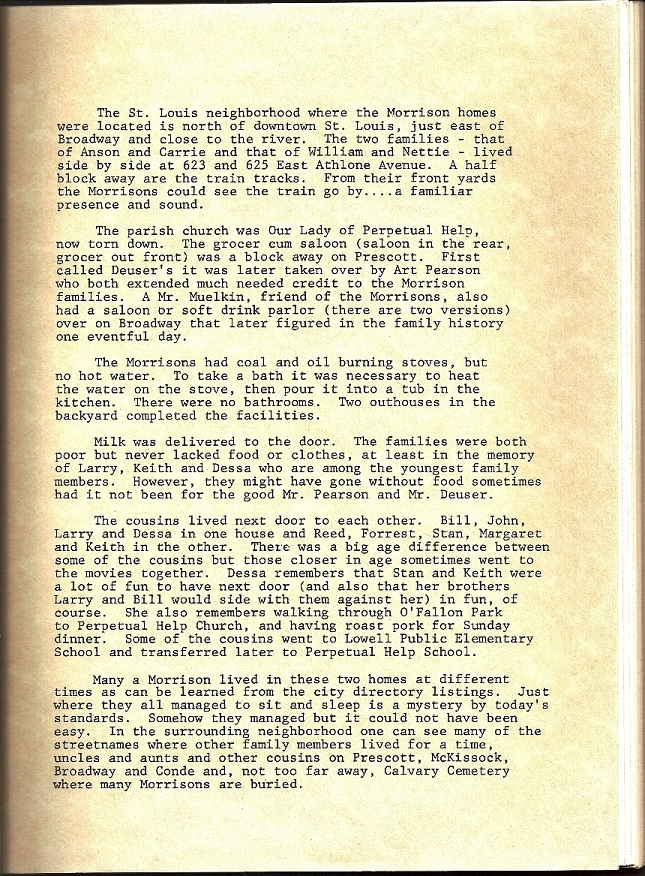
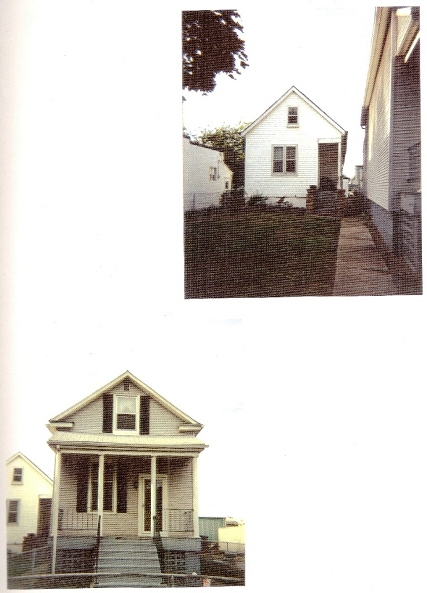
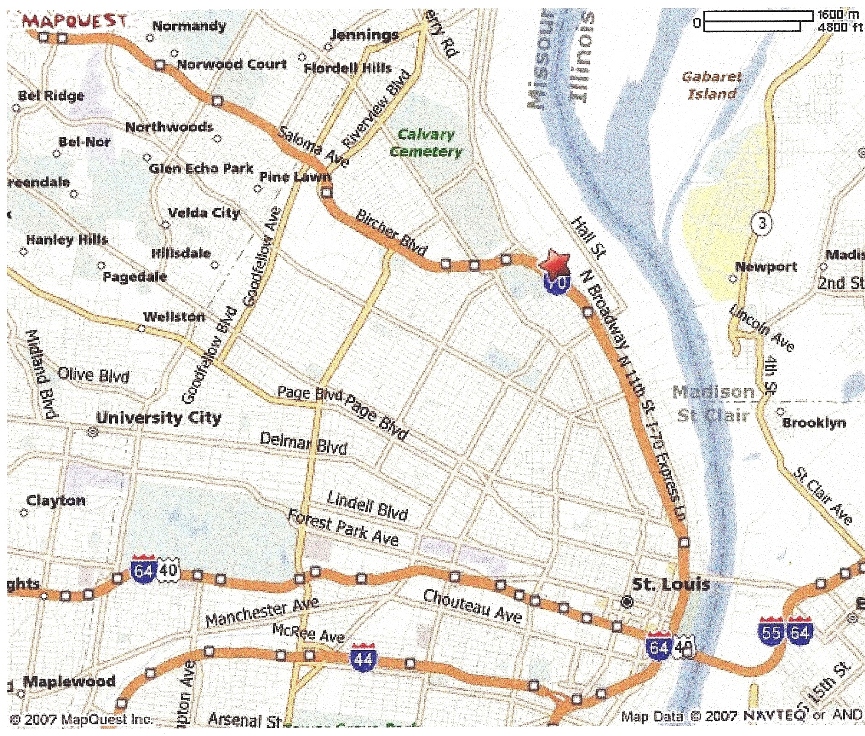
Red Star marks where 625 Athlone Avenue used to be. Was right next to the railroad tracks.